Kristine Hughes's Blog, page 123
July 15, 2012
Dandelions --- Pest or Pretty?
By this time of the summer, there have probably been several generations of dandelions along roadsides, in parks, even in yards. While cheery and welcome early on, to most people they are a nuisance, easily spread, with deep roots and spreading leaves that crowd out more desirrable kinds of grasses.
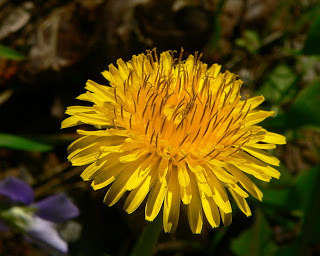
Henrietta Dumont, in the mid-19th century, wrote The Floral Offering: A Token of Affection and Esteem Comprising The Language and Poetry of Flowers (1852):
Dandelion....The Rustic Oracle p. 132
The Dandelion is the most common of flowers. It is found in the four quarters of the globe, near the pole as beneath the equator, on the margin of rivers and streams as well as on sterile rocks. It serves the shepherd instead of a clock, while its feathery tufts are his barometer, predicting calm or storm.
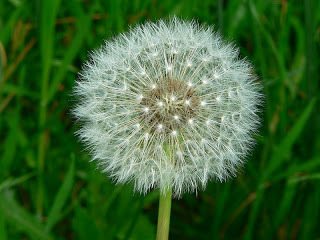
The globes formed by the seeds of the Dandelion are used for other purposes. If you are separated from the objects of your love, pluck one of those feathery spheres, charge each of the little feathers with a tender thought; turn toward the spot where the loved one dwells; blow, and the aerial travellers will faithfully convey your secret message to his or her feet. If you wish to know if that dear one is thinking of you, blow again; and if a single aigrette is left upon the stalk, it is a proof that you are not forgotten. -- Henrietta Dumont
All of us, as children must have blown these little seeds on their feathery way, but I do not recall trying to predict the whereabouts of any of the boys I had a crush on.
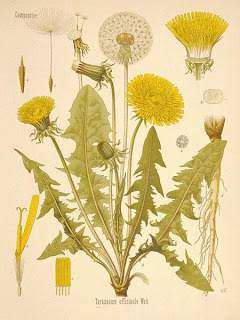
Here are a few excerpts from Medical Botany, Or, Illustrations and Descriptions of the Medicinal Plants of the London, Edinburgh, and Dublin Pharmacopoeias comprising a popular and scientific account of all those Poisonous Vegetables that are indigenous to Great Britain by John Stephenson, and James Morss Churchill. London: John Churchill, Carleton Street, Waterloo Place 1831:
Dandelion: This is a well known perennial inhabitant of our meadows, pastures, and gardens, generally despised as a troublesome weed; and flowering from April, till late in autumn. The root is spindle-shaped, white and fleshy within, and covered externally with a brown epidermis...
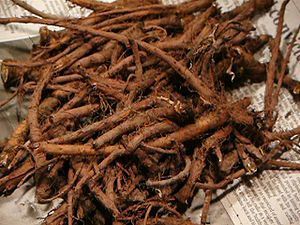 Dandelion RootIt is a fact well known to gardeners, that plants, when blanched, lose many of their active properties; and dandelion thus prepared, is frequently eaten on the continent in salads...
Dandelion RootIt is a fact well known to gardeners, that plants, when blanched, lose many of their active properties; and dandelion thus prepared, is frequently eaten on the continent in salads...
[Here is a recipe for Dandelion Tea]
..an account of my method of preparing the Extractum Leontodinis Taraxaci, which is as follows:
Take of the recent roots of D. four pounds, let them be well bruised in a marble mortar, and the juice expressed; which set aside.
Moisten the pressed roots with two pints of water, bruise them again, and press off the fluid.
Then boil the roots, in as much water as may be sufficient, for an hour; press off the decoction; set it aside to cool; then pour it off from the forces, and mix it with the fluid resulting from the second pressing. Carefully evaporate it with a gentle heat to the consistence of syrup; when cool, let it be intimately mixed with the juice procured by the first pressing; let the extract be now exposed in shallow earthen vessels, (common table dishes or plates will answer the purpose,) until it acquire a stiff pill consistence. If it be left too moist, chemical changes will take place in it, producing acidity.
Extract of dandelion, prepared n the manner detailed above, I have used uncombined in icterus [jaundice], and in various chronic morbid affections of the digestive organs, with the most decided efficacy.
-- Recipe of Joseph Houlton Esq.
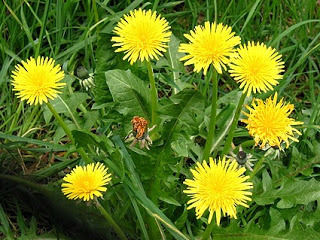
Another direction is taken in the Journal of the Royal Agriculture Society of England, second series, v 16, London: John Murray, Albemarle Street, 1880 p. 94:
Dandelion.--This plant, used to a certain extent in England for medicinal purposes, but otherwise despised by us as a troublesome weed, is now carefully cultivated in France for the purpose of being used as a salad in the middle of winter,...
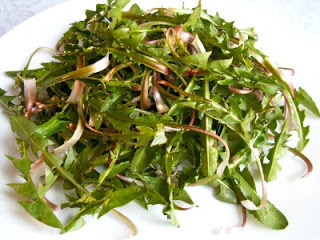
Today's Dandelion Salad from Tammy's Recipes
... after it has been blanched by covering it with earth or sand to the depth of three or four inches for two or three weeks. No less than five varieties are quoted in last year's list of seeds issued by the well-known French seedsmen, Messrs. Vilmorin-Andrieux & Co. Its great merit, in addition to its hygienic properties, is its abundance at a time of year when most other salads are very scarce.
The seed is sown in nursery beds in April, rather a heavy soil being preferred. In May and June the plants are pricked out in rows two feet apart, and eight inches' distance between the plants. The seed may also be sown in rows the same distance apart as before, and the plants afterwards thinned, and singled to a distance of eight or ten inches between them. The plant being indigenous to our climate, as well as to that of France, variations of temperature have very little effect upon it. To obtain the best results and a delicate salad, it is necessary to purchase seed of the improved varieties, as the wild dandelion is coarse in comparison.
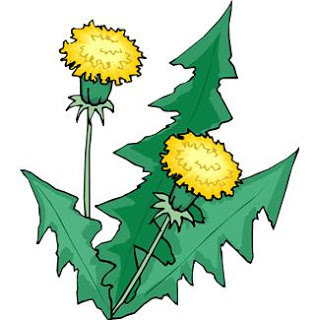
So will this stop you from digging those pesky weeds out of the lawn? Let us know.

Henrietta Dumont, in the mid-19th century, wrote The Floral Offering: A Token of Affection and Esteem Comprising The Language and Poetry of Flowers (1852):
Dandelion....The Rustic Oracle p. 132
The Dandelion is the most common of flowers. It is found in the four quarters of the globe, near the pole as beneath the equator, on the margin of rivers and streams as well as on sterile rocks. It serves the shepherd instead of a clock, while its feathery tufts are his barometer, predicting calm or storm.

The globes formed by the seeds of the Dandelion are used for other purposes. If you are separated from the objects of your love, pluck one of those feathery spheres, charge each of the little feathers with a tender thought; turn toward the spot where the loved one dwells; blow, and the aerial travellers will faithfully convey your secret message to his or her feet. If you wish to know if that dear one is thinking of you, blow again; and if a single aigrette is left upon the stalk, it is a proof that you are not forgotten. -- Henrietta Dumont
All of us, as children must have blown these little seeds on their feathery way, but I do not recall trying to predict the whereabouts of any of the boys I had a crush on.

Here are a few excerpts from Medical Botany, Or, Illustrations and Descriptions of the Medicinal Plants of the London, Edinburgh, and Dublin Pharmacopoeias comprising a popular and scientific account of all those Poisonous Vegetables that are indigenous to Great Britain by John Stephenson, and James Morss Churchill. London: John Churchill, Carleton Street, Waterloo Place 1831:
Dandelion: This is a well known perennial inhabitant of our meadows, pastures, and gardens, generally despised as a troublesome weed; and flowering from April, till late in autumn. The root is spindle-shaped, white and fleshy within, and covered externally with a brown epidermis...
 Dandelion RootIt is a fact well known to gardeners, that plants, when blanched, lose many of their active properties; and dandelion thus prepared, is frequently eaten on the continent in salads...
Dandelion RootIt is a fact well known to gardeners, that plants, when blanched, lose many of their active properties; and dandelion thus prepared, is frequently eaten on the continent in salads...[Here is a recipe for Dandelion Tea]
..an account of my method of preparing the Extractum Leontodinis Taraxaci, which is as follows:
Take of the recent roots of D. four pounds, let them be well bruised in a marble mortar, and the juice expressed; which set aside.
Moisten the pressed roots with two pints of water, bruise them again, and press off the fluid.
Then boil the roots, in as much water as may be sufficient, for an hour; press off the decoction; set it aside to cool; then pour it off from the forces, and mix it with the fluid resulting from the second pressing. Carefully evaporate it with a gentle heat to the consistence of syrup; when cool, let it be intimately mixed with the juice procured by the first pressing; let the extract be now exposed in shallow earthen vessels, (common table dishes or plates will answer the purpose,) until it acquire a stiff pill consistence. If it be left too moist, chemical changes will take place in it, producing acidity.
Extract of dandelion, prepared n the manner detailed above, I have used uncombined in icterus [jaundice], and in various chronic morbid affections of the digestive organs, with the most decided efficacy.
-- Recipe of Joseph Houlton Esq.

Another direction is taken in the Journal of the Royal Agriculture Society of England, second series, v 16, London: John Murray, Albemarle Street, 1880 p. 94:
Dandelion.--This plant, used to a certain extent in England for medicinal purposes, but otherwise despised by us as a troublesome weed, is now carefully cultivated in France for the purpose of being used as a salad in the middle of winter,...

Today's Dandelion Salad from Tammy's Recipes
... after it has been blanched by covering it with earth or sand to the depth of three or four inches for two or three weeks. No less than five varieties are quoted in last year's list of seeds issued by the well-known French seedsmen, Messrs. Vilmorin-Andrieux & Co. Its great merit, in addition to its hygienic properties, is its abundance at a time of year when most other salads are very scarce.
The seed is sown in nursery beds in April, rather a heavy soil being preferred. In May and June the plants are pricked out in rows two feet apart, and eight inches' distance between the plants. The seed may also be sown in rows the same distance apart as before, and the plants afterwards thinned, and singled to a distance of eight or ten inches between them. The plant being indigenous to our climate, as well as to that of France, variations of temperature have very little effect upon it. To obtain the best results and a delicate salad, it is necessary to purchase seed of the improved varieties, as the wild dandelion is coarse in comparison.

So will this stop you from digging those pesky weeds out of the lawn? Let us know.
Published on July 15, 2012 00:56
July 13, 2012
London 2012: Olympic Equestrians
Victoria here, writing about two of my favorite subjects: London (or, rather, make that Greenwich) and horses.
[image error]
I'm hoping that, like 2008, I will be able to watch some of the Olympic Equestrian events between July 27 and August 12. Six sets of medals will be awarded, for individual and team accomplishments in three categories: Eventing, Dressage, and Show Jumping. All three call for the very highest talents, training, and cooperation among horses and riders, and with the Pentathlon, they are the only Olympic sports that involves human-animal collaboration.
[image error]
The venue for the Equestrian events is Greenwich Park on the grounds between the Queen's House and the Greenwich Observatory, a spectacular setting just downriver from London. This newly laid out -- and temporary -- facility was home to an Olympic Test Event last summer.
[image error] 2011
An even better view (below) shows rider Karin Donckers of Belgium in the dressage competition in 2011. Does it get any more spectacular than this, London lovers? There were some protesters, but the powers-that-be promise to return the site to its usual lawn and tree-studded parkland.
[image error]
In 2008, the Olympic Equestrian events were held far from Beijing in Hong Kong, so the competitors are pleased to be more centrally located this year. In 2012, as in 2008, medals will be awarded in six categories, as below, listing the winners in 2008:
In Eventing, Germany won gold, Australia won silver and Great Britain bronze. For the individual medals in Eventing, riders from Germany, the USA, and Great Britain won the gold, silver and bronze medals respectively.
[image error] Zara Phillips, 2012 Team GB in Eventing
In Dressage, the team winners were Germany, the Netherlands and Denmark, while the winning individual riders were from the Netherlands, Germany for both silver and bronze.
[image error] Nicola Wilson, 2012 Team GB in Dressage
The 2008 winners in Show (or Stadium) Jumping were USA, Canada, and Norway; in the individual events, winning riders were from Canada, Sweden, and the USA. Below, Team USA with their 2008 gold medals.
[image error] 2008 Beijing (Hong Kong venue) Olympics
The Equestrian events are clustered as follows:
Eventing: Saturday 28 – Tuesday 31 July
Dressage: Thursday 2 – Thursday 9 August
Jumping: Saturday 4 – Wednesday 8 August
Eventing competitions -- often called Horse Trials -- are three-day series of activities which include dressage, stadium jumping and a 5.7 kilometre cross-country course. All three phases with the same horse and rider require a very high level of training and partnership. 2012 Team GB members in Eventing are: William Fox-Pitt, Nicola Wilson, Mary King, Zara Phillips, and Kristina Cook. Cook won the 2008 individual bronze medal in Eventing.
[image error] Tina Cook 2012 Team GB in Eventing
[image error] William Fox-Pitt, 2012 Team GB in Eventing
Dressage movements are based on refined versions of abilities needed by war horses in combat situations. Like the preliminary rounds of figure skating or gymnastic competitions, a series of prescribed movements are performed and scored, followed by a free-style, though formal, sequence choreographed carefully and set to music. Such refined natural movements as the piaffe, passage and pirouette must be executed. Both horse and rider need intense concentration, intimate control, and perfect harmony.
[image error] Carl Hester, 2012 Team GB in Dressage
[image error] Laura Bechtolsheimer, 2012 Team GB in Dressage
[image error] Charlotte Dujardin, 2012 Team GB in Dressage
Olympic Factoid: At the 2012 Olympics, watch for the dressage appearance of Japan's team member Hiroshi Hoketsu who is competing at age 71, oldest team member in the London games. This is, however, not the all-time oldest of Olympic competitors. Several competitors in the past in shooting competitions have been older.
[image error] Hiroshi Hoketsu, 2012 Team Japan in Dressage
Olympic Factoid: In the long-term medal race in Equestrian events, Germany leads with 28 gold medals, Sweden has 17 golds, France 12, USA 11, and Great Britain 6.
Olympic Factoid: Ian Millar of Team Canada is expected to compete in a record 10th Olympics in Show Jumping. In 2008, when he won the silver medal in Show Jumping, at 61, he was the oldest medal winner of the Beijing Olympics.
[image error] Alan Millar, 2012 Team Canada in Show Jumping
Olympic Factoid: Elizabeth "Beezie" Madden of Team USA was born in Milwaukee, WI, where I live. You needed to know that, right??? Beezie won a bronze medal in individual Show Jumping in 2008 and was a member of both gold-medal Teams USA in 2004 and 2008.
The main website for the 2012 Olympics in London is:http://www.london2012.com/
For more information on the Equestrian Team GB:http://www.equestrianteamgbr.co.uk/london-equestrian-2012/
NBC claims that all 32 sports, all 302 events will be shown on line and most on television, via NBC and its associated networks: MSNBC, CNBC and more.Full details at:http://www.nbcolympics.com/index.html
Specific Equestrian coverage at:http://www.nbcolympics.com/equestrian/index.html
[image error]

[image error]
I'm hoping that, like 2008, I will be able to watch some of the Olympic Equestrian events between July 27 and August 12. Six sets of medals will be awarded, for individual and team accomplishments in three categories: Eventing, Dressage, and Show Jumping. All three call for the very highest talents, training, and cooperation among horses and riders, and with the Pentathlon, they are the only Olympic sports that involves human-animal collaboration.
[image error]
The venue for the Equestrian events is Greenwich Park on the grounds between the Queen's House and the Greenwich Observatory, a spectacular setting just downriver from London. This newly laid out -- and temporary -- facility was home to an Olympic Test Event last summer.
[image error] 2011
An even better view (below) shows rider Karin Donckers of Belgium in the dressage competition in 2011. Does it get any more spectacular than this, London lovers? There were some protesters, but the powers-that-be promise to return the site to its usual lawn and tree-studded parkland.
[image error]
In 2008, the Olympic Equestrian events were held far from Beijing in Hong Kong, so the competitors are pleased to be more centrally located this year. In 2012, as in 2008, medals will be awarded in six categories, as below, listing the winners in 2008:
In Eventing, Germany won gold, Australia won silver and Great Britain bronze. For the individual medals in Eventing, riders from Germany, the USA, and Great Britain won the gold, silver and bronze medals respectively.
[image error] Zara Phillips, 2012 Team GB in Eventing
In Dressage, the team winners were Germany, the Netherlands and Denmark, while the winning individual riders were from the Netherlands, Germany for both silver and bronze.
[image error] Nicola Wilson, 2012 Team GB in Dressage
The 2008 winners in Show (or Stadium) Jumping were USA, Canada, and Norway; in the individual events, winning riders were from Canada, Sweden, and the USA. Below, Team USA with their 2008 gold medals.
[image error] 2008 Beijing (Hong Kong venue) Olympics
The Equestrian events are clustered as follows:
Eventing: Saturday 28 – Tuesday 31 July
Dressage: Thursday 2 – Thursday 9 August
Jumping: Saturday 4 – Wednesday 8 August
Eventing competitions -- often called Horse Trials -- are three-day series of activities which include dressage, stadium jumping and a 5.7 kilometre cross-country course. All three phases with the same horse and rider require a very high level of training and partnership. 2012 Team GB members in Eventing are: William Fox-Pitt, Nicola Wilson, Mary King, Zara Phillips, and Kristina Cook. Cook won the 2008 individual bronze medal in Eventing.
[image error] Tina Cook 2012 Team GB in Eventing
[image error] William Fox-Pitt, 2012 Team GB in Eventing
Dressage movements are based on refined versions of abilities needed by war horses in combat situations. Like the preliminary rounds of figure skating or gymnastic competitions, a series of prescribed movements are performed and scored, followed by a free-style, though formal, sequence choreographed carefully and set to music. Such refined natural movements as the piaffe, passage and pirouette must be executed. Both horse and rider need intense concentration, intimate control, and perfect harmony.
[image error] Carl Hester, 2012 Team GB in Dressage
[image error] Laura Bechtolsheimer, 2012 Team GB in Dressage
[image error] Charlotte Dujardin, 2012 Team GB in Dressage
Olympic Factoid: At the 2012 Olympics, watch for the dressage appearance of Japan's team member Hiroshi Hoketsu who is competing at age 71, oldest team member in the London games. This is, however, not the all-time oldest of Olympic competitors. Several competitors in the past in shooting competitions have been older.
[image error] Hiroshi Hoketsu, 2012 Team Japan in Dressage
Olympic Factoid: In the long-term medal race in Equestrian events, Germany leads with 28 gold medals, Sweden has 17 golds, France 12, USA 11, and Great Britain 6.
Olympic Factoid: Ian Millar of Team Canada is expected to compete in a record 10th Olympics in Show Jumping. In 2008, when he won the silver medal in Show Jumping, at 61, he was the oldest medal winner of the Beijing Olympics.
[image error] Alan Millar, 2012 Team Canada in Show Jumping
Olympic Factoid: Elizabeth "Beezie" Madden of Team USA was born in Milwaukee, WI, where I live. You needed to know that, right??? Beezie won a bronze medal in individual Show Jumping in 2008 and was a member of both gold-medal Teams USA in 2004 and 2008.
The main website for the 2012 Olympics in London is:http://www.london2012.com/
For more information on the Equestrian Team GB:http://www.equestrianteamgbr.co.uk/london-equestrian-2012/
NBC claims that all 32 sports, all 302 events will be shown on line and most on television, via NBC and its associated networks: MSNBC, CNBC and more.Full details at:http://www.nbcolympics.com/index.html
Specific Equestrian coverage at:http://www.nbcolympics.com/equestrian/index.html
[image error]
Published on July 13, 2012 01:21
July 10, 2012
England in Song
A few weeks ago, on May 30, 2012, we posted a story The Milwaukee Symphony Goes British in a concert Victoria attended. Here's another musical blog (though without a note) about British song.
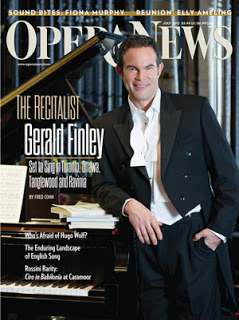
"There'll Always Be an England" is the title of an article in Opera News magazine, a publication of the Metropolitan Opera Guild. Hilary Finch, Music Critic of The Times of London writes about the enduring delights of British song. The article is here.
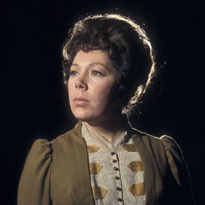 Janet Baker, acclaimed British mezzo
Janet Baker, acclaimed British mezzo
Ms. Finch asks, "So what is it about the English soul, as expressed in English song, that has such a powerful pull worldwide, and generation after generation?" For her answers, I direct you to the article, which I guarantee you will enjoy.Music is always synonymous with Britain to me, whether it be the folk songs or the country dances we learned in school, many of which were transferred across the Atlantic almost unchanged, or the modern classics of Benjamin Britten or Ralph Vaughan Williams. Jane Austen lovers know the music well, from the copies of songs Jane herself wrote out, now to be seen at the Jane Austen Museum at Chawton Cottage...
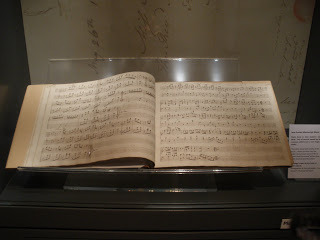
...to the lively soundtracks of the many versions of her stories. There are also many CDs of music from her time for the fortepiano and other instruments.
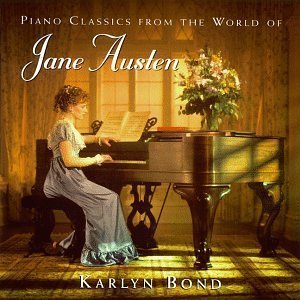
For a selection of Austen-related books on and CDs of her music, try the JaneAusten Books website,
The Sunday New York Times Arts Section on July 8, 2012, carried an article (here) about the centennial of the birth of Kathleen Ferrier, an acclaimed contralto from Lancashire, who died in 1953 at the early age of 41, but left an enduring legacy in her recordings. There are several YouTube versions of Ferrier singing. She often sang English folk music as well as Bach, Handel, and Mahler.
[image error] Kathleen Ferrier (1912-1953)
One amusing tidbit from the Hilary Finch article is her nod to the British penchant for nonsense verse. I could not agree more. The lines of Edward Lear (The Owl and the Pussycat) and Lewis Carroll (Alice's Adventures) are every bit as deserving of a tune as the dialect-laden lines of Robert Burns or the elegant works of Shakespeare or Byron.
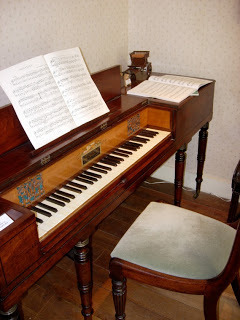 Piano on Display at Jane Austen House Museum (not hers, but very similar)
Piano on Display at Jane Austen House Museum (not hers, but very similar)
And dare I write of English music without mentioning everyone's favorites, the Boys from Liverpool? British pop music is famous worldwide.
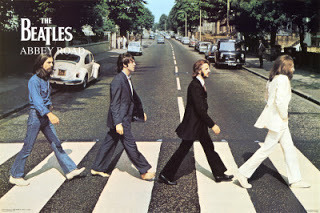
And starting this month in London, another season of The Proms; their website is here.

So, sing out, everyone!

"There'll Always Be an England" is the title of an article in Opera News magazine, a publication of the Metropolitan Opera Guild. Hilary Finch, Music Critic of The Times of London writes about the enduring delights of British song. The article is here.
 Janet Baker, acclaimed British mezzo
Janet Baker, acclaimed British mezzoMs. Finch asks, "So what is it about the English soul, as expressed in English song, that has such a powerful pull worldwide, and generation after generation?" For her answers, I direct you to the article, which I guarantee you will enjoy.Music is always synonymous with Britain to me, whether it be the folk songs or the country dances we learned in school, many of which were transferred across the Atlantic almost unchanged, or the modern classics of Benjamin Britten or Ralph Vaughan Williams. Jane Austen lovers know the music well, from the copies of songs Jane herself wrote out, now to be seen at the Jane Austen Museum at Chawton Cottage...

...to the lively soundtracks of the many versions of her stories. There are also many CDs of music from her time for the fortepiano and other instruments.

For a selection of Austen-related books on and CDs of her music, try the JaneAusten Books website,
The Sunday New York Times Arts Section on July 8, 2012, carried an article (here) about the centennial of the birth of Kathleen Ferrier, an acclaimed contralto from Lancashire, who died in 1953 at the early age of 41, but left an enduring legacy in her recordings. There are several YouTube versions of Ferrier singing. She often sang English folk music as well as Bach, Handel, and Mahler.
[image error] Kathleen Ferrier (1912-1953)
One amusing tidbit from the Hilary Finch article is her nod to the British penchant for nonsense verse. I could not agree more. The lines of Edward Lear (The Owl and the Pussycat) and Lewis Carroll (Alice's Adventures) are every bit as deserving of a tune as the dialect-laden lines of Robert Burns or the elegant works of Shakespeare or Byron.
 Piano on Display at Jane Austen House Museum (not hers, but very similar)
Piano on Display at Jane Austen House Museum (not hers, but very similar)And dare I write of English music without mentioning everyone's favorites, the Boys from Liverpool? British pop music is famous worldwide.

And starting this month in London, another season of The Proms; their website is here.

So, sing out, everyone!
Published on July 10, 2012 23:20
July 8, 2012
The Passing of the Duke of Cambridge
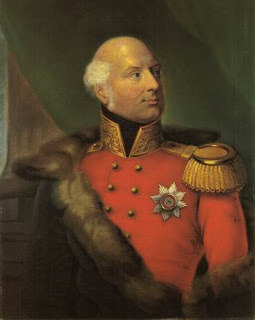
Prince Adolphus., Duke of Cambridge
From The Letters of Queen Victoria
Queen Victoria to the King of the Belgians. Buckingham Palace, 9th July 1850.
My Dearest Uncle,—We live in the midst of sorrow and death! My poor good Uncle Cambridge breathed his last, without a struggle, at a few minutes before ten last night. I still saw him yesterday morning at one, but he did not see me, and to-day I saw him lifeless and cold. The poor Duchess and the poor children are very touching in their grief, and poor Augusta,1 who arrived just five hours too late, is quite heart-broken. The end was most peaceful; there was no disease; only a gastric fever, which came on four weeks ago, from over-exertion and cold, and which he neglected for the first week, carried him off.The good Prince of Prussia you will have been pleased to talk to and see. Having lived with him for a fortnight on a very intimate footing, we have been able to appreciate his real worth fully; he is so honest and frank, and so steady of purpose and courageous. Poor dear Peel is to be buried to-day. The sorrow and grief at his death are most touching, and the country mourns over him as over a father. Every one seems to have lost a personal friend.As I have much to write, you will forgive my ending here. You will be glad to hear that poor Aunt Gloucester is wonderfully calm and resigned. My poor dear Albert, who had been so fresh and well when we came back, looks so pale and fagged again. He has felt, and feels, Sir Robert's loss dreadfully. He feels he has lost a second father.
May God bless and protect you all, you dear ones! Ever your devoted Niece, Victoria R.
Published on July 08, 2012 23:31
July 7, 2012
Johann Zoffany by Jo Manning - Part Two
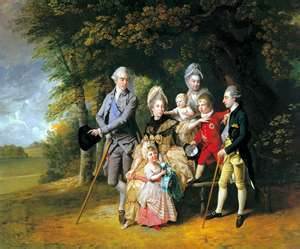
Queen Charlotte with her Children and Brothers - Zoffany 1773
Akin to the group paintings of the Sharps, Gores, Impeys, and Queen Charlotte’s family, is Zoffany’s cluttered-with-many-many-bodies iconic painting of the founding members of the Royal Academy – a painting faithfully reproduced whenever a piece about that august association is published – showing the two female founders, Mary Moser (a painter of exquisite still life, mostly flowers in vases) and Angelika Kauffmann (a renowned allegory painter whose work can be seen on ceilings at the Royal Academy building at Piccadilly Circus). They are on the wall, not 100% part of this mostly male group.
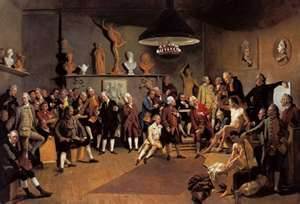
The Royal Academicians, circa 1771-1772
The painting brutally conveys the message that no women were allowed to pursue life studies, paintings using nude male models. While the men are intently engaged upon the muscular attributes of these young and muscular men, these women are framed in portraits on the wall, woefully gazing at each other, far removed from the action below.
I was quite familiar with the RA painting, as I have been doing research on 18th century female painters for some years, but I had not had the opportunity to see in full force the magnificence of his famous Tribuna Of The Uffizi, painted over the years 1772-78, when Zoffany resided in Italy. The Tribuna is an octagonal room in the Uffizi Gallery in Florence that was designed for the De Medicis in the late 1580s, and where the most important collections of that family were displayed. Zoffany here portrays the northeast section of the room, but varies their arrangement – artistic license – deliberately adding works that were not normally displayed there.
This is a fabulous work, simply fabulous! My initial assessment of Zoffany’s work was now seriously challenged as I gazed upon this wonder. So much is taking place: connoisseurs discussing a nude painting; young men on their Grand Tour gazing appreciatively and lustfully at the buttocks of a marble statue of Venus; a youth eying the sketch a gentleman is making of another marble statue; and, everywhere, exquisite renderings of great works of art. One could never tire of looking at so many minute details and musing upon the vignettes told so amusingly by the artist.
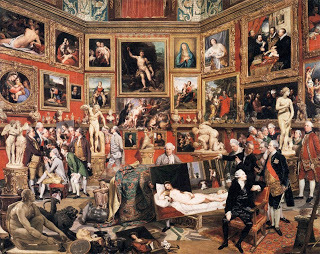 A Tribute to the Ufizzi - 1775
A Tribute to the Ufizzi - 1775As Alastair Sooke recently described it in the Telegraph :
“[The exhibit includes] a staggering picture called The Tribuna of the Uffizi, which is often described as the best painting he ever made. Commissioned by Queen Charlotte, consort of George III, it took Zoffany the best part of the 1770s to complete. Amid a tumult of famous works inside the Tribuna room of the Uffizi Gallery in Florence, Grand Tourists can be seen chin-wagging. Zoffany includes more than 20 portraits of miscellaneous toffs surrounded by replicas of masterpieces by Holbein, Rubens, Raphael and others.
“An emblem of the curious, acquisitive spirit of the 18th century, it is spectacularly detailed. As its rhythms ripple across the retina, the eye’s muscles have to work overtime to keep up with the profusion of the artist’s vision. The unifying bright red of the background, though, deftly prevents the composition from swirling into chaos.
“Part of the fun comes from spotting works of art (a Raphael Madonna here, a nude by Titian there), almost in the manner of the Where’s Wally? children’s books. But as well as being learned, the painting is full of hearty innuendo, as Zoffany satirises the less-than-lofty aspirations of the English ‘milordi’ who set off on the Grand Tour in search of amatory, not artistic, conquests. A group of five men gaze adoringly at the sculpted bottom of the Medici Venus (one uses an eyeglass to get a really good look). Elsewhere, there are visual gags about buggery. The work is a wonderful reminder that the 18th century was as rowdy as it was refined. Perhaps this explains why Zoffany’s royal patron wasn’t enamoured with the finished piece, which was relegated to Kew Palace.”
(If you want to know more about this piece, check out Oliver Millar’s Zoffany And His Tribuna, which contain the expanded and illustrated notes of a lecture given by Millar on the subject at the Courtauld Institute in 1964.)
Sooke’s well-written, almost poetic piece (“rhythms ripple across the retina”) segues into my what-I-didn’t-know-about-Johann-Zoffany story quite nicely. The buggery jokes… ! The gentleman who has his hand on the canvas of the Venus of Urbino, by Titian, and seems to be pointing to the statue of the naked wrestlers, is one Thomas Patch, a scoundrel who’d been exiled from Rome for homosexuality/aka/buggery. (This depiction of Patch, in particular, seemed to have offended Queen Charlotte, the “royal patron”; she and her husband the King can be said to have had a limited sense of humor.)
So, then, Zoffany was not as boring as his court/society/family portraits might have indicated. Indeed, he was an urbane, witty man who was involved in his share of scandal…befitting the 18th century, that great age for scandal. As Sooke comments further, he “was an urbane chap with an eye for the ladies and an appetite for the finer things in life.” How true, how true, is this last comment!
For he was apparently also a bigamist, marrying his pregnant second wife – his very young mistress, who’d stowed aboard the ship carrying him to Rome – whilst still married to his first wife, who lived apart from him in Germany. This “marriage” was, obviously, illegal while his first wife was alive and they were not divorced.
This intrigued me greatly, so I looked into it further, consulting the excellent 2011 biography by Mary Webster (Yale University Press 2011). Zoffany had married Maria Juliana Antonetta Eiselein in Wurzberg, Germany, and had moved to London with him. Claiming homesickness, she left him early on, before 1771, but then returned briefly, only to leave him again around 1772, with the same complaint of missing her family and country.
In 1772, Zoffany took out what is called “letters of denization”, declaring he desired to switch his religious affiliation from Roman Catholic to Protestant. His biographer Mary Webster says, by way of explanation, that “German Protestants were allowed to divorce on grounds of incompatibility without incurring any social disgrace to either side.” (Rather enlightened, that!) So, was this an attempt to divorce Maria Juliana Antonetta? It might have been, but he never followed through with an action. (Webster further speculates that it might have upset his Roman Catholic family in southern Germany if he were actually to divorce his wife.) Instead, he sent her back home with an annuity; they remained married but never saw each other again. They’d had no children together.
With Mrs Zoffany gone, there were rumors that the artist had taken up with the wife of “an Israelite”, an unnamed Jewish woman. There was also talk that he roamed the London streets looking for young girls. This last bit of information comes from a well-connected German woman at the court of King George III named Mrs Charlotte Papendieck, who was to become a close friend and confidante of Zoffany’s next mistress – and, eventually, his wife – the teenager Mary Thomas. Mary – described as a very beautiful girl -- was said in Mrs P’s memoirs to have told her the story of how she met Zoffany.
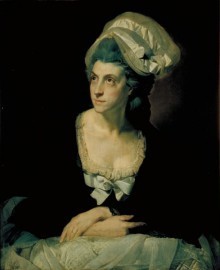
Mary Thomas, circa 1781, at the Ashmolean, Oxford, the artist’s second wife…
Though Mrs Papendieck’s memoirs were later disputed as to their veracity by the Zoffany’s children and grandchildren, what she has to say is fascinating. According to the 2011 book edited by Martin Postle:
“Mary Thomas, the daughter of a London glove maker, first met Zoffany sometime in the winter of 1771 or early the following year. [This would be about the time Maria Juliana Antonetta fled London for Germany the second time.] Mary’s own account of her life with Zoffany was recorded in the memoirs of her friend Charlotte Papiendieck. According to Mrs Papendieck, Mary had told her how Zoffany, who ‘in his leisure hours prowled around for victims of self-gratification’, had stalked her to her parents’ ‘humble dwelling’. Shortly afterwards, he left for Italy. On discovering that she was pregnant, Mary stowed away on the boat, making herself known to Zoffany during the voyage. On arrival in Italy, Zoffany apparently told Mary his German wife had died a few months earlier, and so ‘he married the object of his affection, who became a mother at 16’.”
In Webster’s biography, there is some discussion as to whether she might have been 14 at the time she became pregnant. She could also have been closer to 17, but there is no definitive proof to corroborate this. She may indeed have become a mother at 16. He was 39, a good 20+ years older than she. (If she was really 14, it would have been a difference of 25 years in age!)
Mary Thomas gave birth to Zoffany’s first child we know of, a boy, in Italy. Zoffany may have gone through a form of marriage with her in Genoa that the girl thought was legal – she was very young and said to be rather naïve and shy – and he supposedly told her his wife had died – but the first Mrs Z was very much alive in 1772. (She died in Germany in 1805, 33 years later.) From 1772 onwards, however, Mary Thomas was to pass as Zoffany’s wife.
Tragedy struck when the baby was 16 months old and he fell from a go-cart down a steep set of stairs in Florence; the severe head injury was to kill him three weeks later. They went on to have four daughters together, two before he left for India in 1783 – without Mary – and two more daughters after he returned to her.
While in India, he was reputed to have taken up with an Indian woman and had at least one child, perhaps more. According to the Postle book, “Given his own libidinous predisposition, it was inevitable that he should have taken an Indian mistress, with whom he had several children, including a son.” Though it is hard to establish that he had “several children”, there seems to be agreement that he did have at least one son with his Indian mistress. This child was said to have been left in the household of a French nawab, Claude Martin, a man with whom Zoffany had been very friendly, but the little boy has been lost in the mists of time. Nothing more was ever heard of him again, nor of any other children he might have sired with this Indian woman.
Zoffany returned quite wealthy to England in 1788 after his sojourn in India and settled into that very nice home on Strand-on-the-Green. But, according to that old gossip and gadabout, diarist/letter-writer Horace Walpole, he came back “in more wealth than health”. India’s climate was harsh on Europeans, and diseases -- before the advent of antibiotics – caused the deaths of many expatriates. But although he was said to be weakened in health, Zoffany lived for 22 more years. It was at 65 Strand-on-the-Green, that beautiful home on the river, where he died.
I’m standing by his tomb at the head of this piece, and here are more photographs from that churchyard many of you might have passed on the way to Kew Gardens:
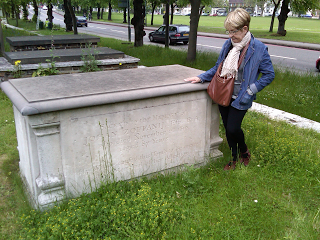 St Anne’s, Kew, with the road to Kew Gardens, that great botanical showpiece, in the background. This inscription is of Mary Thomas, Zoffany’s second wife, who died in the great cholera outbreak in 1832, 22 years after the death of her husband…
St Anne’s, Kew, with the road to Kew Gardens, that great botanical showpiece, in the background. This inscription is of Mary Thomas, Zoffany’s second wife, who died in the great cholera outbreak in 1832, 22 years after the death of her husband…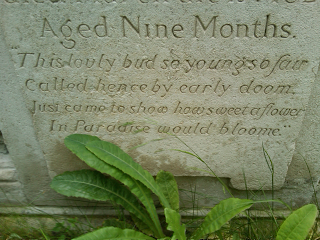
This was one of his grandchildren…a baby girl…
I can’t identify the grandchild, nor the year of her death, nor whose daughter she was, which child of his four daughters’ children. (As I mentioned previously, there were four daughters of his marriage with Mary Thomas and a boy who died before the age of two years whose name I could not verify.)
The first two girls Zoffany had with Mary Thomas were Maria Theresa (1774), who was called Theresa, and Cecelia (1779); the last two were Claudina (1794) and Laura (1796). Their father left them ample dowries of £2,000 each and all made “good” marriages. To his wife Mary he left the house on Strand-on-the-Green and money for her upkeep. But there was a restriction on the house: she would lose it if she remarried. Though she received at least one known proposal – from the wealthy sculptor Joseph Nollekens -- she never did remarry.
And what of that first wife moldering away in Germany? She passed away in January of 1805, so that bigamist Zoffany finally wed Mary Thomas at St Pancras Church on April 20th, four months after receiving word of his first wife’s death. Zoffany was 72; she was by then probably in her late 40s. They were to be legally wed only five years; the painter, who suffered from severe dementia in his last years of life, passed away in 1810. Mary Thomas outlived him by 22 years, dying in 1832 from the great cholera epidemic in London; sadly, their eldest daughter Theresa died within a few days of her mother from the same outbreak of disease.
Quite a life our peripatetic Johann Zoffany led...
One would hardly have known it, from his (mostly) sedate paintings. And he was a fun fellow, too. This painting shocked me, but only because it was the Zoffany I had not known, a man who hung condoms on his wall and dressed as a friar to take part in a bacchanalia one can only imagine!
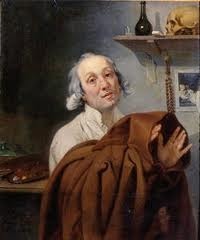 He’s dressing up a Franciscan monk, according to the caption, preparing for a night out on the town J
He’s dressing up a Franciscan monk, according to the caption, preparing for a night out on the town JI go into condoms in great detail in my biography of Grace Dalrymple Elliott, My Lady Scandalous. If you are interested, read all about 18th century prophylactic use there. I leave you with the bon vivant, in this later, rather happy, self-portrait, painted when Zoffany was 43 years of age…and already, alas, losing his hair:
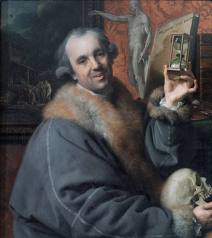 Still that skull, reminder of time running out…mortality, mortality…but that’s a smile on his face as he no doubt recalls his naughty sexual escapades well into his late middle age. He had a good life, methinks, despite his early loss of hair. Painted circa 1776…
Still that skull, reminder of time running out…mortality, mortality…but that’s a smile on his face as he no doubt recalls his naughty sexual escapades well into his late middle age. He had a good life, methinks, despite his early loss of hair. Painted circa 1776…
Published on July 07, 2012 00:34
July 5, 2012
Johann Zoffany by Guest Blogger Jo Manning
Who
Ever
Knew That About Johann Zoffany (1733-1810)… part one
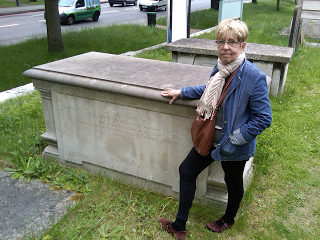
Jo Manning at the tomb of Johann Zoffany and some of his family members, St Anne’s Church, Kew, on a very cold and very grey day at the end of May 2012. (I am wearing 5 layers of clothing.) Nearby is the tomb of Thomas Gainsborough who, born six years before Zoffany, predeceased him by twenty-two years. The tomb was restored in 2008…
And here is Gainsborough’s tomb, close to the wall of the church. It was restored in the late 19th century, by an admirer of the painter, because it had fallen into such disrepair…
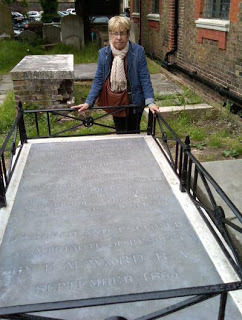
Gainsborough shares his eternal rest with his wife and his nephew and protege, the talented Gainsborough DuPont, who died much too young…
But, back to Johann Zoffany, whom I’d always considered rather…well, why not say it: boring. Yes, boring. All those courtly paintings of royals and assorted aristocratic or rich mercantile families and groups… He had to be as ho-hum as his subjects, no?
Totally boring!
Well, how wrong can someone be? Terribly wrong, as I was to find out. The man had some interesting aspects to his persona, not all of them admirable, but…ho-hum, he was not! His life fit right into the scandal-ridden 18th century.
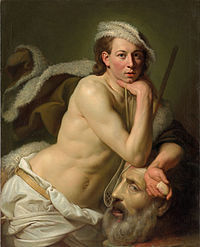
Self-portrait as David with the head of Goliath, 1756
Johann Zoffany was one of the first of the 18th century artists I came across in my researching of the London art scene a few decades ago. He was competent enough, but his paintings seemed just that, competent, not too exciting. A good man with the brush, for sure, but, really, his subjects?
Let me take you with me on my journey to find who the man was behind the prolific and successful painter, the real Johann Zoffany, and this, only because the Royal Academy of Art has just had a major exhibit of sixty of his most important works.
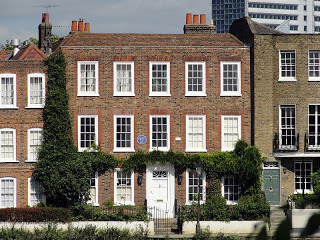
Zoffany’s former home at 65 Strand-on-the-Green, London, right on and across the river from Kew. A blue plaque is affixed between the 2nd and third windows, at the level above the front door. This is a lovely area, but one subject to major flooding when the river rises. Zoffany at one time owned several other houses on either side of Number 65…
Though among the founding members of the Royal Academy, the group organized in 1768 at the expressed wish of King George III, a group which very soon became the premier association of artists in Britain, Zoffany’s been generally overlooked among the artists in that august body. In the last three years, however, three major and all-encompassing books on him have been published, the last two in 2011.
Born in Germany, near Frankfurt, his original surname was spelled Zauffaly. Like his fellow academician John Hoppner (a portraitist also of German descent), he is not usually remembered in the pantheon of the best-known of the Georgian painters. You can be forgiven for not recognizing his name.
The sad fact for perfectly good and talent artists like Zoffany and Hoppner (and so many others during that time) was that the 18th century art world was dominated by the affable friend-to-all Sir Joshua Reynolds (first president of the Royal Academy, a favorite of royal and aristocratic society), and his contemporary and rival, Thomas Gainsborough (though he could never be described as affable, much less friendly J
Not only were these two artists favored and favorites because of their talent, but because they gained fame by painting the day’s celebrities – the rich, the heroic, the notorious, the beautiful, and the very colorful – becoming household as well as society names. Reynolds was, in addition, a workaholic with so many commissions he had to employ a stable of assistants to paint in background and even costume. He and Gainsborough were the rock stars of the period, the go-to portraitists for high society, i.e., those aristocrats who comprised the ton.
It was difficult to compete in the same arena as those two artistic giants. George Romney tried, and he did have his followers, but no one at that time was to equal the fame of Reynolds or Gainsborough, fame that endures to the present day. One critic opined that Zoffany was perhaps too German, too peripatetic, and too mercurial, to be taken seriously. Strange comments, but there might be something there. The German artists had their own clique within the RA clique, and Zoffany was definitely a wanderer who spent a lot of time away, from Germany to England, to Italy (a lot of time in Florence), to India, then back again to England. Some Georgian artists never left England, or, if they did go to Italy to study art, did so not more than once. Zoffany was all over the place. Peripatetic, indeed.
And the “mercurial” comment… I think it implies that there was more to him than one suspected. Like quicksilver, he was hard to pin down, more in his personal life, perhaps, than in his painting life. That is, just when you thought you knew him…he was not what he seemed. This can confuse critics, as it certainly did me.
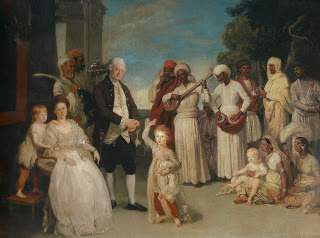
The Impey Family, India, circa 1783
Worse than the fate of the male artists who tried to compete were the many excellent female artists of the day, who fell through the proverbial cracks and are still little known – if not entirely unknown -- to historians. There were thousands of good artists in Britain, a good number of whom had trained on the continent (Italy, in particular), but not all made money; some were quite destitute. Painters not that successful competing in London who were intent on increasing their fortunes went on to pursue commissions in India, working for the nabobs (also spelled nawabs), the British and European traders who’d become millionaires, and the Indian princely classes. Zoffany, in fact, lived in Lucknow, India, for about two years at the same time his friend and colleague the miniaturist Ozias Humphry went there, residing within a wide circle of European nawabs. In all, his stay in India totaled some five years.
Of the Impey family group portrait above, Judith Flanders commented in her recent Seven magazine review:
“In India he shows us a world where the Victorian stratification of society into ‘European’ and ‘native’ remain in the future, and images such as The Impey Family show how Indian and British cultures intermixed, as the small Impey daughter, in Indian dress, dances barefoot to the accompaniment of Indian musicians, applauded by her watching father. In other paintings European sitters clutch hookahs, or weave Indian fabrics into their headdresses. It is always through these objects, through their possessions, that Zoffany’s sitters speak, to their own world and to ours today.”
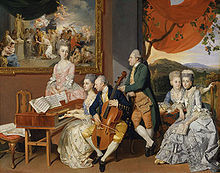
The Gore Family, circa 1775
If Zoffany is known at all, it is for paintings like this, of royals and wealthy families. His canvases are filled with figures – and he is a nonpareil figurative painter – but gazing upon one too many of these works – dubbed conversazione, or “conversation pieces”, aka informal group portraits -- can become yawn-inducing. Above are the six members of the amateur musical Gore family and the professional musician family, the Sharps (I swear, that is actually their surname, Sharp), below, set pieces showing both families’ most treasured possessions, their musical instruments.
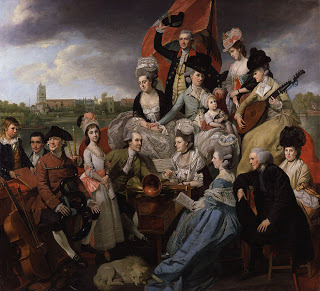
The Sharp Family on the Thames, circa 1779-1781
Critics have dubbed Zoffany a master of this painting type, a genre that developed on the continent and came to Britain in the first decades of the 18th century. These set “conversation pieces” have their admirers and detractors but no one can deny that these paintings are not technically well painted, the work of a master painter skilled in group portraiture.
He also painted individual portraits of King George III and of Queen Charlotte (flattering both of them immensely), portraits which are not terribly memorable (see below), and tend towards (as one critic put it) the “homey”:
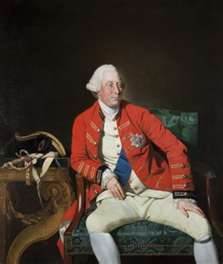
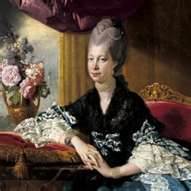
King George III could not be more relaxed in this portrait, legs splayed, arms relaxed. Queen Charlotte could have been flattered a bit more by the artist in her portrait; alas, she was not a handsome woman. Below is a delightful group portrait showing the queen with some of her children, her brothers, and a nursemaid hovering in the background, also tending to the “homey,” again, not terribly exciting, but competently executed.
Part Two Coming Soon!


Jo Manning at the tomb of Johann Zoffany and some of his family members, St Anne’s Church, Kew, on a very cold and very grey day at the end of May 2012. (I am wearing 5 layers of clothing.) Nearby is the tomb of Thomas Gainsborough who, born six years before Zoffany, predeceased him by twenty-two years. The tomb was restored in 2008…
And here is Gainsborough’s tomb, close to the wall of the church. It was restored in the late 19th century, by an admirer of the painter, because it had fallen into such disrepair…

Gainsborough shares his eternal rest with his wife and his nephew and protege, the talented Gainsborough DuPont, who died much too young…
But, back to Johann Zoffany, whom I’d always considered rather…well, why not say it: boring. Yes, boring. All those courtly paintings of royals and assorted aristocratic or rich mercantile families and groups… He had to be as ho-hum as his subjects, no?
Totally boring!
Well, how wrong can someone be? Terribly wrong, as I was to find out. The man had some interesting aspects to his persona, not all of them admirable, but…ho-hum, he was not! His life fit right into the scandal-ridden 18th century.

Self-portrait as David with the head of Goliath, 1756
Johann Zoffany was one of the first of the 18th century artists I came across in my researching of the London art scene a few decades ago. He was competent enough, but his paintings seemed just that, competent, not too exciting. A good man with the brush, for sure, but, really, his subjects?
Let me take you with me on my journey to find who the man was behind the prolific and successful painter, the real Johann Zoffany, and this, only because the Royal Academy of Art has just had a major exhibit of sixty of his most important works.

Zoffany’s former home at 65 Strand-on-the-Green, London, right on and across the river from Kew. A blue plaque is affixed between the 2nd and third windows, at the level above the front door. This is a lovely area, but one subject to major flooding when the river rises. Zoffany at one time owned several other houses on either side of Number 65…
Though among the founding members of the Royal Academy, the group organized in 1768 at the expressed wish of King George III, a group which very soon became the premier association of artists in Britain, Zoffany’s been generally overlooked among the artists in that august body. In the last three years, however, three major and all-encompassing books on him have been published, the last two in 2011.
Born in Germany, near Frankfurt, his original surname was spelled Zauffaly. Like his fellow academician John Hoppner (a portraitist also of German descent), he is not usually remembered in the pantheon of the best-known of the Georgian painters. You can be forgiven for not recognizing his name.
The sad fact for perfectly good and talent artists like Zoffany and Hoppner (and so many others during that time) was that the 18th century art world was dominated by the affable friend-to-all Sir Joshua Reynolds (first president of the Royal Academy, a favorite of royal and aristocratic society), and his contemporary and rival, Thomas Gainsborough (though he could never be described as affable, much less friendly J
Not only were these two artists favored and favorites because of their talent, but because they gained fame by painting the day’s celebrities – the rich, the heroic, the notorious, the beautiful, and the very colorful – becoming household as well as society names. Reynolds was, in addition, a workaholic with so many commissions he had to employ a stable of assistants to paint in background and even costume. He and Gainsborough were the rock stars of the period, the go-to portraitists for high society, i.e., those aristocrats who comprised the ton.
It was difficult to compete in the same arena as those two artistic giants. George Romney tried, and he did have his followers, but no one at that time was to equal the fame of Reynolds or Gainsborough, fame that endures to the present day. One critic opined that Zoffany was perhaps too German, too peripatetic, and too mercurial, to be taken seriously. Strange comments, but there might be something there. The German artists had their own clique within the RA clique, and Zoffany was definitely a wanderer who spent a lot of time away, from Germany to England, to Italy (a lot of time in Florence), to India, then back again to England. Some Georgian artists never left England, or, if they did go to Italy to study art, did so not more than once. Zoffany was all over the place. Peripatetic, indeed.
And the “mercurial” comment… I think it implies that there was more to him than one suspected. Like quicksilver, he was hard to pin down, more in his personal life, perhaps, than in his painting life. That is, just when you thought you knew him…he was not what he seemed. This can confuse critics, as it certainly did me.

The Impey Family, India, circa 1783
Worse than the fate of the male artists who tried to compete were the many excellent female artists of the day, who fell through the proverbial cracks and are still little known – if not entirely unknown -- to historians. There were thousands of good artists in Britain, a good number of whom had trained on the continent (Italy, in particular), but not all made money; some were quite destitute. Painters not that successful competing in London who were intent on increasing their fortunes went on to pursue commissions in India, working for the nabobs (also spelled nawabs), the British and European traders who’d become millionaires, and the Indian princely classes. Zoffany, in fact, lived in Lucknow, India, for about two years at the same time his friend and colleague the miniaturist Ozias Humphry went there, residing within a wide circle of European nawabs. In all, his stay in India totaled some five years.
Of the Impey family group portrait above, Judith Flanders commented in her recent Seven magazine review:
“In India he shows us a world where the Victorian stratification of society into ‘European’ and ‘native’ remain in the future, and images such as The Impey Family show how Indian and British cultures intermixed, as the small Impey daughter, in Indian dress, dances barefoot to the accompaniment of Indian musicians, applauded by her watching father. In other paintings European sitters clutch hookahs, or weave Indian fabrics into their headdresses. It is always through these objects, through their possessions, that Zoffany’s sitters speak, to their own world and to ours today.”

The Gore Family, circa 1775
If Zoffany is known at all, it is for paintings like this, of royals and wealthy families. His canvases are filled with figures – and he is a nonpareil figurative painter – but gazing upon one too many of these works – dubbed conversazione, or “conversation pieces”, aka informal group portraits -- can become yawn-inducing. Above are the six members of the amateur musical Gore family and the professional musician family, the Sharps (I swear, that is actually their surname, Sharp), below, set pieces showing both families’ most treasured possessions, their musical instruments.

The Sharp Family on the Thames, circa 1779-1781
Critics have dubbed Zoffany a master of this painting type, a genre that developed on the continent and came to Britain in the first decades of the 18th century. These set “conversation pieces” have their admirers and detractors but no one can deny that these paintings are not technically well painted, the work of a master painter skilled in group portraiture.
He also painted individual portraits of King George III and of Queen Charlotte (flattering both of them immensely), portraits which are not terribly memorable (see below), and tend towards (as one critic put it) the “homey”:


King George III could not be more relaxed in this portrait, legs splayed, arms relaxed. Queen Charlotte could have been flattered a bit more by the artist in her portrait; alas, she was not a handsome woman. Below is a delightful group portrait showing the queen with some of her children, her brothers, and a nursemaid hovering in the background, also tending to the “homey,” again, not terribly exciting, but competently executed.
Part Two Coming Soon!
Published on July 05, 2012 23:17
July 4, 2012
There's An App For That
On this momentous day in the history of the United States and Great Britain, we thought we'd take a look not back, but forwards. It was only a matter of time before London tourists were empowered by technology. There are now a host of apps to make your next trip to the Old Smoke that much easier/more enjoyable. We've rounded up some of the smartest, most useful apps available today, any one of which would have made Prince Puckler-Muskau swoon with delight.

The London Tube App by Presslite (above) and the London Underground Free (below) both offer route maps, real time status updates, line delays, GPS locting and station exit locations.

London Bus Stop Live (screenshot above) providing live departure information for every bus stop in London - real time bus departure times as predicted by the onboard GPS system in each bus. There's no more getting wet waiting for buses, no more missing the last bus home and no more wondering if there's time to nip into the shop or not. In fact there's no more waiting for a bus ever again. Welcome to 21st century London.

The London Taxi Fare Calculator allows you to check the fare for a taxi between two points anywhere in London, uses the iPhone’s GPS and iPhone maps to make the calculations and predict the best route, and has preset points of interest such as tourist attractions, landmarks, train stations, tube stations and airports.

London Mini A-Z - This map is a digital rendition of the famous “London A-Z Mini Atlas” and covers an area from West Hendon in the North West to Grove Park in the South East. Add this application to your iPhone or iPod Touch and you will have instant access to all 352 pages of the London Mini A-Z printed map.

The Time Out London app puts everything that’s great about the capital in one place, with information on gigs, events, bars, restaurants, club nights and film releases. Whether you’re out and about or planning from home, it’s simple to organise your days and nights out in London and invite your friends.
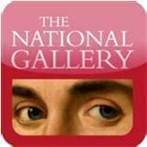
National Gallery - Take a virtual tour of the National Gallery's collection, search by artist or time period and save screenshots of artwork on your phone or upload to Facebook. You can also listen to the stories behind the masterpieces in insightful interviews with artists, writers and experts.
Quirky London - If you want to find out where in-the-know Londoners go for a mid-week meet-up, a lively Saturday night out or an off-the-beaten-track Sunday stroll then this is the app for you. Packed with the museums, art galleries, restaurants, pubs, clubs and venues that make London truly great, Quirky London uncovers the city's secrets and presents them to you in one easy-to-follow guide complete with maps, images and the nitty gritty info you need for your visit.

The Hidden London app will help you discover nearly 50 unusual, amazing, intriguing and surprising places to visit.
+ Discover a "Roman" bath right in the centre of London.
+ Hang out with Dennis the Menace and friends in London's only cartoon museum.
+ Explore a mysterious crypt hidden in the depths of Fleet Street.
+ Browse through the first English dictionary in the 18th century house where it was written.
+ Investigate Sherlock Holmes' most famous cases and consult with Dr Watson.
+ Visit Pango the pig, DJ the horse and even a few friendly dinosaurs.
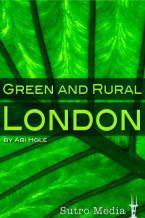
The Green and Rural London app describes and maps London's finest parks, gardens, squares, secret green boltholes, cemeteries, commons, and urban farms. Whenever you feel in need of a breath of fresh air, a moment's repose, a wander around lawns and flowers, a playground, or a place to eat your lunch al fresco, turn to this app.
Urban Spoon - Search for local restaurants by neighborhood, cuisine or price. Find reviews from local newspapers, food blogs and fellow diners.

London On A Plate - this note-book guide contains personal reviews on some of London’s most valued food shops and restaurants, shopping pages, guiding you on must-haves to wear to dinner or ideas to dress your own dining table, from some of the capital’s most respected design talent. Markets to see and time to be inspired distilled into one pocket bible. One of the key purposes of this guide is to provide the home cook with recipes from some of London’s finest chefs, including John Torode, Fergus Henderson, Anna Hansen, Mark Hix, Peter Gordon and Sam and Sam Clark.
London City Slicker - London City Slicker brings the colour and history of London to life on your iPhone. Hours of superbly produced Video and Audio help you delve into the secrets and stories relating to London’s fabulous heritage and the people who lived there. Superbly crafted walking-tours have been created for anyone interesting in exploring or finding out more about London, without the cost of a Tour-Guide. Famous historian Adam Heart Davis takes you through important London sites on themed walks of about 2 miles in length or a few hours in duration. With integrated Google Maps, getting around the walking-tours could not be easier.
And we've saved the best London app for last - this one deserves its own drum roll -

The Time Travel Explorer app lets you explore historic London as it was in the past - Georgian, Regency and Victorian eras included. This version contains the mapping engine, the central area of London from Stamford's 1862 map and a modern map of the same area. It also contains over 750 points of interest, 150 audio guides and over 1500 old and new pictures. The remainder of the 1862 map and additional historic maps from 1830 (Greenwood), 1799 (Horwood) and 1746 (Rocque) are available as separate purchases.
Time Travel Explorer - London Pro provides a bundle of all four maps at a discounted price. With TTX you can:
- follow your route on antique maps that show you the streets and buildings from centuries ago
- use GPS to show you what lies beneath the modern city and what has survived to the present day
- click on points of interest to get detailed information about your location
- get the highlights of London's history right where you need them.
Features
- high-quality digitised images of important historical maps*
- 750 points of interest with full descriptions
- 1500 photos including life in London over 100 years ago**
- 150 audio guides**
- expert tour information from a qualified Blue Badge guide
- seamless transfer from one era to another - travel through time
Welcome to the 21st Century!

The London Tube App by Presslite (above) and the London Underground Free (below) both offer route maps, real time status updates, line delays, GPS locting and station exit locations.

London Bus Stop Live (screenshot above) providing live departure information for every bus stop in London - real time bus departure times as predicted by the onboard GPS system in each bus. There's no more getting wet waiting for buses, no more missing the last bus home and no more wondering if there's time to nip into the shop or not. In fact there's no more waiting for a bus ever again. Welcome to 21st century London.

The London Taxi Fare Calculator allows you to check the fare for a taxi between two points anywhere in London, uses the iPhone’s GPS and iPhone maps to make the calculations and predict the best route, and has preset points of interest such as tourist attractions, landmarks, train stations, tube stations and airports.

London Mini A-Z - This map is a digital rendition of the famous “London A-Z Mini Atlas” and covers an area from West Hendon in the North West to Grove Park in the South East. Add this application to your iPhone or iPod Touch and you will have instant access to all 352 pages of the London Mini A-Z printed map.

The Time Out London app puts everything that’s great about the capital in one place, with information on gigs, events, bars, restaurants, club nights and film releases. Whether you’re out and about or planning from home, it’s simple to organise your days and nights out in London and invite your friends.

National Gallery - Take a virtual tour of the National Gallery's collection, search by artist or time period and save screenshots of artwork on your phone or upload to Facebook. You can also listen to the stories behind the masterpieces in insightful interviews with artists, writers and experts.
Quirky London - If you want to find out where in-the-know Londoners go for a mid-week meet-up, a lively Saturday night out or an off-the-beaten-track Sunday stroll then this is the app for you. Packed with the museums, art galleries, restaurants, pubs, clubs and venues that make London truly great, Quirky London uncovers the city's secrets and presents them to you in one easy-to-follow guide complete with maps, images and the nitty gritty info you need for your visit.

The Hidden London app will help you discover nearly 50 unusual, amazing, intriguing and surprising places to visit.
+ Discover a "Roman" bath right in the centre of London.
+ Hang out with Dennis the Menace and friends in London's only cartoon museum.
+ Explore a mysterious crypt hidden in the depths of Fleet Street.
+ Browse through the first English dictionary in the 18th century house where it was written.
+ Investigate Sherlock Holmes' most famous cases and consult with Dr Watson.
+ Visit Pango the pig, DJ the horse and even a few friendly dinosaurs.

The Green and Rural London app describes and maps London's finest parks, gardens, squares, secret green boltholes, cemeteries, commons, and urban farms. Whenever you feel in need of a breath of fresh air, a moment's repose, a wander around lawns and flowers, a playground, or a place to eat your lunch al fresco, turn to this app.
Urban Spoon - Search for local restaurants by neighborhood, cuisine or price. Find reviews from local newspapers, food blogs and fellow diners.

London On A Plate - this note-book guide contains personal reviews on some of London’s most valued food shops and restaurants, shopping pages, guiding you on must-haves to wear to dinner or ideas to dress your own dining table, from some of the capital’s most respected design talent. Markets to see and time to be inspired distilled into one pocket bible. One of the key purposes of this guide is to provide the home cook with recipes from some of London’s finest chefs, including John Torode, Fergus Henderson, Anna Hansen, Mark Hix, Peter Gordon and Sam and Sam Clark.
London City Slicker - London City Slicker brings the colour and history of London to life on your iPhone. Hours of superbly produced Video and Audio help you delve into the secrets and stories relating to London’s fabulous heritage and the people who lived there. Superbly crafted walking-tours have been created for anyone interesting in exploring or finding out more about London, without the cost of a Tour-Guide. Famous historian Adam Heart Davis takes you through important London sites on themed walks of about 2 miles in length or a few hours in duration. With integrated Google Maps, getting around the walking-tours could not be easier.
And we've saved the best London app for last - this one deserves its own drum roll -

The Time Travel Explorer app lets you explore historic London as it was in the past - Georgian, Regency and Victorian eras included. This version contains the mapping engine, the central area of London from Stamford's 1862 map and a modern map of the same area. It also contains over 750 points of interest, 150 audio guides and over 1500 old and new pictures. The remainder of the 1862 map and additional historic maps from 1830 (Greenwood), 1799 (Horwood) and 1746 (Rocque) are available as separate purchases.
Time Travel Explorer - London Pro provides a bundle of all four maps at a discounted price. With TTX you can:
- follow your route on antique maps that show you the streets and buildings from centuries ago
- use GPS to show you what lies beneath the modern city and what has survived to the present day
- click on points of interest to get detailed information about your location
- get the highlights of London's history right where you need them.
Features
- high-quality digitised images of important historical maps*
- 750 points of interest with full descriptions
- 1500 photos including life in London over 100 years ago**
- 150 audio guides**
- expert tour information from a qualified Blue Badge guide
- seamless transfer from one era to another - travel through time
Welcome to the 21st Century!
Published on July 04, 2012 00:54
July 2, 2012
Christie's - The Exceptional Sale
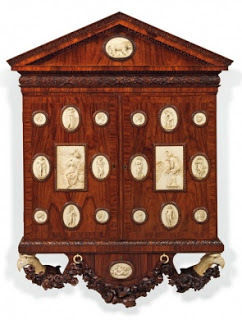
“Brand Cabinet,” ca 1743. Est: £800,000-1,200,000. Photo: Christie’s Images.
The Exceptional Sale, taking place on 5 July in King Street, London, is Christie’s premier auction for the decorative arts. This exclusive annual sale includes the finest works of art in a variety of categories, from furniture and sculpture, to porcelain, silver and clocks. It is carefully curated to include only the very best examples.
From the Christie's Press Release:
In 2008 Christie’s launched a unique sale platform for the very best decorative arts; The Exceptional Furniture Sale saw 10 masterpiece works realise a total of £10.3 million. Building on the success of this sale and The Exceptional Sale held in 2011, Christie’s is pleased to announce details of The Exceptional Sale 2012 which will take place on the evening of 5 July. Comprising 48 lots, the sale presents three centuries of decorative arts, from the first quarter of the 16th century to the first quarter of the 19th century. Featuring the finest examples of furniture, silver, sculpture, clocks and porcelain – including recent discoveries and previously unknown examples – the sale exemplifies the very best of European decorative arts. It is expected to realise a total in excess of £13 million. Robert Copley, Deputy Chairman Christie’s UK, International Head of Furniture and Decorative Arts states: ‘With The Exceptional Sale Christie’s celebrates excellence in furniture and the decorative arts. The attributes of this carefully curated auction are provenance, rarity, design, and craftsmanship. From exquisite furniture by André-Charles Boulle and Thomas Chippendale to the magnificent Leinster silver dinner-service; from a rare maiolica plate by Nicola da Urbino to a newly discovered marble group by Jan van Delen; from glittering Chinese clocks and ormolu-mounted porcelain to the finest examples of Italian pietre dure, The Exceptional Sale offers collectors an opportunity to acquire the very best.’
The exceptional Brand Cabinet (above), a George II ivory-mounted padouk medal-cabinet, circa 1743 (estimate: £800,000-1,200,000), was made for the wealthy young Dilettante Thomas Brand, who like many English milordi went on The Grand Tour, arriving in Rome in 1738. It is here that he probably purchased the ivory plaques that depict figures from Classical mythology such as Leda and the Swan. A couple of years later, Brand’s contemporary and ‘intimate friend’ Horace Walpole also made the Tour. On his return he designed a cabinet to house his precious ‘enamels and miniatures’. No doubt inspired by William Kent, his cabinet and Brand’s are both made of padouk and are attributed to William Hallett of Great Newport Street, in Covent Garden. Walpole’s cabinet subsequently hung in the Tribune at Strawberry Hill and is now in the Victoria and Albert Museum, while Brand’s cabinet remained at the family house, The Hoo, in Hertfordshire until it was first sold at Christie’s in 1938.
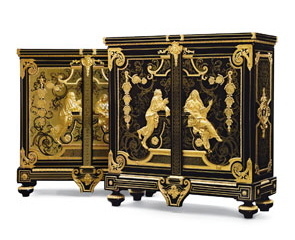 The Ogden Mills ‘Armoires à Six Medailles’ (above) are lavishly decorated with spectacular gilt-bronze mounts that fuse seamlessly with the scrolling foliate pattern of the sumptuous ground of brass and tortoiseshell première and contre-partie marquetry (estimate: £1,000,000–1,500,000). The Louis XIV armoire in contre partie is attributed to André-Charles Boulle, while the late Louis XVI in première partie is by Delorme. They are decorated to the doors with trails of medals celebrating the Life of Louis XIV as well as the figures of Aspasia and Socrates. Conceived initially with shelves to house collections of precious medals this series of armoires proved so successful it remained in production in Boulle’s workshop throughout the first half of the 18th century and was subsequently continued by Boulle’s followers.
The Ogden Mills ‘Armoires à Six Medailles’ (above) are lavishly decorated with spectacular gilt-bronze mounts that fuse seamlessly with the scrolling foliate pattern of the sumptuous ground of brass and tortoiseshell première and contre-partie marquetry (estimate: £1,000,000–1,500,000). The Louis XIV armoire in contre partie is attributed to André-Charles Boulle, while the late Louis XVI in première partie is by Delorme. They are decorated to the doors with trails of medals celebrating the Life of Louis XIV as well as the figures of Aspasia and Socrates. Conceived initially with shelves to house collections of precious medals this series of armoires proved so successful it remained in production in Boulle’s workshop throughout the first half of the 18th century and was subsequently continued by Boulle’s followers.To view the sale catalogue online, visit the Christie's link here.
Published on July 02, 2012 00:01
June 30, 2012
The Spirit of Chartwell
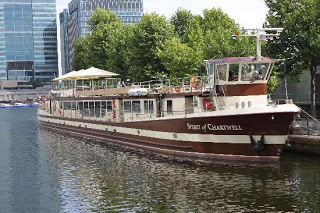
Do you recognize this vessel, The Spirit of Chartwell?
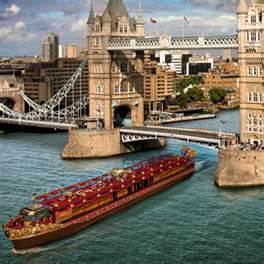
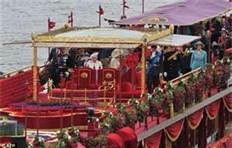
How about now? Yes, the Spirit of Chartwell was kitted out in all it's regal glory as the Queen's Jubilee Barge during the recent Thames Pageant. She is the only cruise vessel capable of navigating both the upper courses of the Thames and the open sea. She has two lounges, open-air viewing areas and a unique third floor dining room, complete with an elevating roof. The Spirit of Chartwell can easily accommodate up to 36 passengers in 18 comfortable guest cabins across two decks. The ship was designed to evoke the timeless grandeur of the 1929 Cote d'Azur Pullman railway carriage complete with artefacts from the original train and great ocean liners of yesteryear.
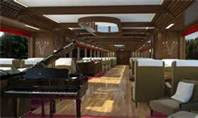
The 'Spirit of Chartwell's' pièce de résistance is the George Bradshaw Lounge/Restaurant together with the adjoining Somerset Maugham Piano Bar resplendent in rich mahogany finishes, motif studded hardwood flooring, sculptured tables, Lalique glass inlaid panelling and intricate marquetry.
Nice to know that we commoners can also book a day cruise aboard the Spirit of Chartwell. Their Sunday Glory cruise allows guests to spend a lazy Sunday afternoon onboard with Sunday lunch and High Tea being served onboard while you sail along the Thames and take in London's iconic landmarks at a cost of £120 per guest at a' Riviera' Armchair Table Setting for up to six guests.
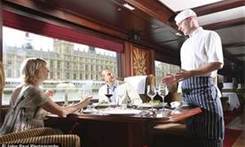
The Memories of London package provides a circle cruise from Cadogan Pier at Chelsea, sailing first towards the Thames Barrier then upstream past London's iconic landmarks before returning to Canary Wharf. Calls are made at Greenwich and Tate Britain with optional overnight State Cabin accommodation. Included in the fare, which begins at £220, are a Captain's Welcome Champagne Reception, three course luncheon, high tea buffet and five gala course dinner.
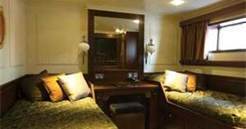
If you're looking for a longer cruise, as part of Ace Cultural Cruises, the Spirit of Chartwall embarks on a six day London and River Thames cruise that takes in Greeenwich, Rochester, Chartwell, Cliveden House and Blenheim Palace. Full details can be accessed at the company website, available here.
Click here to watch video of the Royal Family boarding the Spirit of Chartwell for the Thames Jubilee Pageant.
Published on June 30, 2012 00:58
June 27, 2012
The Story of English Heritage by Guest Blogger Jo Manning

[Full disclosure: my daughter, a wall painting conservator, has worked for English Heritage since her graduation from London’s Courtauld Institute of Art]
English Heritage is the conservation arm – overseeing the “built environment” -- of the British government, with specialists providing advice on every level to all groups, including local authorities and property owners and maintaining over 400 historic properties for the enjoyment of the British public and of tourists and visitors. Its official title is the Historic Building and Monuments Commission for England, and is administered by the Department for Culture, Media, and Sport. (Sport?!) It was founded under the National Heritage Act of 1983, assuming the duties of the Ancient Monuments Board, the Historic Buildings Council, and the Royal Commission on the Historical Monuments of England.
Their London office is in Holborn, in a handsome Victorian Gothic Revival building designed by the noted architect Alfred Waterhouse, whose best-known work is London’s Natural History Museum:
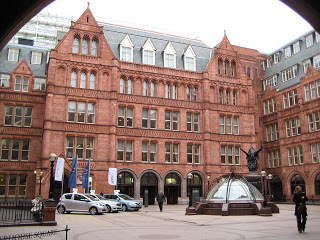
Waterhouse Square: English Heritage's London Office
© English Heritage, Richard Dumville
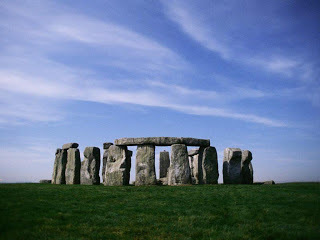
Over 11 million visitors a year go to these historic sites, of which some 750,000 are members. For a mere £47 a year (that’s less than a hundred dollars US), one can become a member of EH and gain admission to well-known properties like Stonehenge to far lesser-known – and even obscure – properties such as the Burial Ground Wall North of the Friends Meeting House in Burgh by Sands, Carlisle, Cumbria.
Since 1986, the iconic round Blue Plaques, seen on historic buildings all over London has been administered by English Heritage; the program itself has been in existence since 1866. Described as “a uniquely successful means of connecting people” with the places in which they resided, it has inspired like plaques in many other places, including areas outside of London in the United Kingdom. For the history of these plaques, click here.
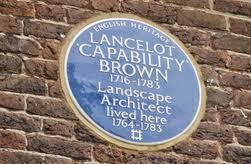
It’s interesting to note that among the first names considered for this program – which was the idea of a William Ewart, an MP in the House of Commons, in 1863 -- were Benjamin Franklin, David Garrick, and Lord Nelson. The first plaque erected, in 1867, named the poet Lord Byron; it was his birthplace, 24 Holles Street, Cavendish Square. Unfortunately, the house was demolished twenty-two years later. The earliest of these plaques to survive, dating from the same year, commemorated Napoleon III in King Street, St. James’s. Did you know that anyone can suggest a blue plaque? See further details here. And, if you'd like to create your own virtual blue plaque, click here. To order a real, three dimensional personalized any way you like, click here.
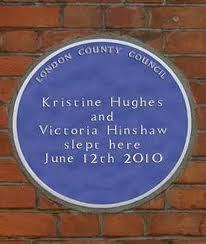
English Heritage also pursues an active publications program. Click here for more information.
[image error]
Published on June 27, 2012 23:59
Kristine Hughes's Blog
- Kristine Hughes's profile
- 6 followers
Kristine Hughes isn't a Goodreads Author
(yet),
but they
do have a blog,
so here are some recent posts imported from
their feed.



